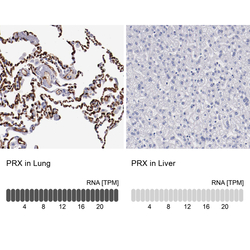Antibody data
- Antibody Data
- Antigen structure
- References [13]
- Comments [0]
- Validations
- Immunohistochemistry [1]
Submit
Validation data
Reference
Comment
Report error
- Product number
- HPA001868 - Provider product page

- Provider
- Atlas Antibodies
- Proper citation
- Atlas Antibodies Cat#HPA001868, RRID:AB_2172440
- Product name
- Anti-PRX
- Antibody type
- Polyclonal
- Description
- Polyclonal Antibody against Human PRX, Gene description: periaxin, Alternative Gene Names: KIAA1620, Validated applications: IHC, Uniprot ID: Q9BXM0, Storage: Store at +4°C for short term storage. Long time storage is recommended at -20°C.
- Reactivity
- Human
- Host
- Rabbit
- Conjugate
- Unconjugated
- Isotype
- IgG
- Vial size
- 100 µl
- Concentration
- 0.2 mg/ml
- Storage
- Store at +4°C for short term storage. Long time storage is recommended at -20°C.
- Handling
- The antibody solution should be gently mixed before use.
Submitted references Schwannosis in the brain of a neonatal calf
Double‐edged effects of tamoxifen‐in‐oil‐gavage on an infectious murine model for multiple sclerosis
Phenotypical changes of satellite glial cells in a murine model of GM1‐gangliosidosis
Phenotypical peculiarities and species‐specific differences of canine and murine satellite glial cells of spinal ganglia
Vitamin C regulates Schwann cell myelination by promoting DNA demethylation of pro‐myelinating genes
Virus-triggered spinal cord demyelination is followed by a peripheral neuropathy resembling features of Guillain-Barré Syndrome
The Origins and Vulnerabilities of Two Transmissible Cancers in Tasmanian Devils
Regression of devil facial tumour disease following immunotherapy in immunised Tasmanian devils
Canine dorsal root ganglia satellite glial cells represent an exceptional cell population with astrocytic and oligodendrocytic properties
Immunohistochemical and transcriptome analyses indicate complex breakdown of axonal transport mechanisms in canine distemper leukoencephalitis
Primary Postnatal Dorsal Root Ganglion Culture from Conventionally Slaughtered Calves
A second transmissible cancer in Tasmanian devils
Contribution of Schwann Cells to Remyelination in a Naturally Occurring Canine Model of CNS Neuroinflammation
Bochynska D, Sharpe A, Toland B, Demeter E
Journal of Veterinary Diagnostic Investigation 2024;37(1):160-163
Journal of Veterinary Diagnostic Investigation 2024;37(1):160-163
Double‐edged effects of tamoxifen‐in‐oil‐gavage on an infectious murine model for multiple sclerosis
Hülskötter K, Jin W, Allnoch L, Hansmann F, Schmidtke D, Rohn K, Flügel A, Lühder F, Baumgärtner W, Herder V
Brain Pathology 2021;31(6)
Brain Pathology 2021;31(6)
Phenotypical changes of satellite glial cells in a murine model of GM1‐gangliosidosis
Huang B, Zdora I, de Buhr N, Eikelberg D, Baumgärtner W, Leitzen E
Journal of Cellular and Molecular Medicine 2021;26(2):527-539
Journal of Cellular and Molecular Medicine 2021;26(2):527-539
Phenotypical peculiarities and species‐specific differences of canine and murine satellite glial cells of spinal ganglia
Huang B, Zdora I, de Buhr N, Lehmbecker A, Baumgärtner W, Leitzen E
Journal of Cellular and Molecular Medicine 2021;25(14):6909-6924
Journal of Cellular and Molecular Medicine 2021;25(14):6909-6924
Vitamin C regulates Schwann cell myelination by promoting DNA demethylation of pro‐myelinating genes
Huff T, Sant D, Camarena V, Van Booven D, Andrade N, Mustafi S, Monje P, Wang G
Journal of Neurochemistry 2020;157(6):1759-1773
Journal of Neurochemistry 2020;157(6):1759-1773
Virus-triggered spinal cord demyelination is followed by a peripheral neuropathy resembling features of Guillain-Barré Syndrome
Leitzen E, Raddatz B, Jin W, Goebbels S, Nave K, Baumgärtner W, Hansmann F
Scientific Reports 2019;9(1)
Scientific Reports 2019;9(1)
The Origins and Vulnerabilities of Two Transmissible Cancers in Tasmanian Devils
Stammnitz M, Coorens T, Gori K, Hayes D, Fu B, Wang J, Martin-Herranz D, Alexandrov L, Baez-Ortega A, Barthorpe S, Beck A, Giordano F, Knowles G, Kwon Y, Hall G, Price S, Pye R, Tubio J, Siddle H, Sohal S, Woods G, McDermott U, Yang F, Garnett M, Ning Z, Murchison E
Cancer Cell 2018;33(4):607-619.e15
Cancer Cell 2018;33(4):607-619.e15
Regression of devil facial tumour disease following immunotherapy in immunised Tasmanian devils
Tovar C, Pye R, Kreiss A, Cheng Y, Brown G, Darby J, Malley R, Siddle H, Skjødt K, Kaufman J, Silva A, Baz Morelli A, Papenfuss A, Corcoran L, Murphy J, Pearse M, Belov K, Lyons A, Woods G
Scientific Reports 2017;7(1)
Scientific Reports 2017;7(1)
Canine dorsal root ganglia satellite glial cells represent an exceptional cell population with astrocytic and oligodendrocytic properties
Tongtako W, Lehmbecker A, Wang Y, Hahn K, Baumgärtner W, Gerhauser I
Scientific Reports 2017;7(1)
Scientific Reports 2017;7(1)
Immunohistochemical and transcriptome analyses indicate complex breakdown of axonal transport mechanisms in canine distemper leukoencephalitis
Spitzbarth I, Lempp C, Kegler K, Ulrich R, Kalkuhl A, Deschl U, Baumgärtner W, Seehusen F
Brain and Behavior 2016;6(7)
Brain and Behavior 2016;6(7)
Primary Postnatal Dorsal Root Ganglion Culture from Conventionally Slaughtered Calves
Badea T, Fadda A, Bärtschi M, Hemphill A, Widmer H, Zurbriggen A, Perona P, Vidondo B, Oevermann A
PLOS ONE 2016;11(12):e0168228
PLOS ONE 2016;11(12):e0168228
A second transmissible cancer in Tasmanian devils
Pye R, Pemberton D, Tovar C, Tubio J, Dun K, Fox S, Darby J, Hayes D, Knowles G, Kreiss A, Siddle H, Swift K, Lyons A, Murchison E, Woods G
Proceedings of the National Academy of Sciences 2015;113(2):374-379
Proceedings of the National Academy of Sciences 2015;113(2):374-379
Contribution of Schwann Cells to Remyelination in a Naturally Occurring Canine Model of CNS Neuroinflammation
de Castro F, Kegler K, Spitzbarth I, Imbschweiler I, Wewetzer K, Baumgärtner W, Seehusen F
PLOS ONE 2015;10(7):e0133916
PLOS ONE 2015;10(7):e0133916
No comments: Submit comment
Supportive validation
- Submitted by
- Atlas Antibodies (provider)
- Enhanced method
- Orthogonal validation
- Main image

- Experimental details
- Immunohistochemistry analysis in human lung and liver tissues using HPA001868 antibody. Corresponding PRX RNA-seq data are presented for the same tissues.
- Sample type
- Human
- Protocol
- Protocol
 Explore
Explore Validate
Validate Learn
Learn Immunohistochemistry
Immunohistochemistry